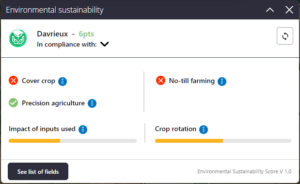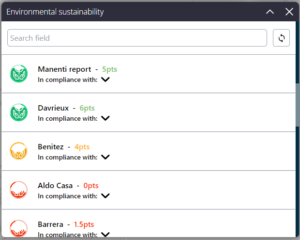The index called “Environmental Sustainability” allows you to measure and compare different practices in different fields that generate a positive environmental impact on the crop.
The values of this index range from 0 to 10, with fields with values close to 0 having the lowest environmental sustainability, and those close to 10 having the highest sustainability.
The following parameters are used to calculate the index per field:
- Cover crop: Analyzes whether a cover crop was declared in the current campaign. (Recorded in Rotations).
- Use of precision agriculture: Analyzes whether variable input management is used in the field. (Recorded in Maps).
- Impact of inputs used: By comparing the amount used and the EIQ* of the components used between the current and previous campaign, it is analyzed whether there was a higher efficiency in their use. (Recorded in Application log).
- No-till: Analyzes/verifies whether no-till was used as a method in the current campaign.(Recorded in Sowing).
- Crop rotation: Analyzes the crops declared in the last 4 years and verifies whether crop rotations were carried out and the complexity of these.(Recorded in (Recorded in Rotations).
*NOTE: For those components for which an EIQ from official sources is not available at the moment, the statistical value will be taken from existing data to estimate the EIQ. This value may be modified as a result of future updates to the database.
EIQ of Field: = EIQ x % Concentration of active ingredient x Dose
To access the “Environmental Sustainability” extension, you must enter the marketplace within the analysis module and enable this extension.
Here we tell you how to use the “Environmental Sustainability” Extension
You can view the environmental sustainability index by field:

You can also view the environmental sustainability index by field to compare:

Supporting documentation:

